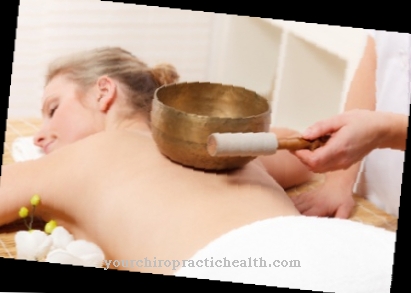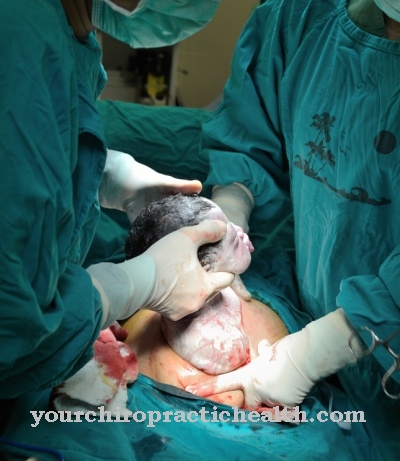The Moxibustion, also Moxa therapy or short Moxes called, is a special variant of acupuncture and belongs to traditional Chinese medicine, TCM. In contrast to classic acupuncture, needles are not always used in moxing. The basis of the moxa therapy consists in the warming of certain acupuncture points by burning off finely ground mugwort.
What is the moxibustion?

In moxibustion, acupuncture points are stimulated by heat. Tiny amounts of dried mugwort fibers, known as moxa, are burned directly onto or over certain areas of the skin. These skin points that are being treated lie on the energy channels, the so-called meridians, and by and large correspond to those of the acupuncture points.
These are distributed all over the body. The Qi, the body's own energy, flows in the pathways. The stimulation through the heating of the points should release energy blockages and thus bring the energy back to flow. The mugwort, which is used as a moxa herb, has been an effective medicinal plant for thousands of years and penetrates deep into the body when it is heated. The most important components of mugwort include essential oils such as camphor and thujone, the sesquiterpene lactones vulgarin and pilostachyin, the flavonoids quercetin and rutin, the hydroxycoumarins umbelliferin and esculetin.
In addition, polyines, triterpenes and carotenoids are part of the medicinal herb. The leaves of the medicinal plant are collected and dried in spring and then processed into fine cotton wool. In order to achieve an even glow over the acupuncture points, a uniform, fine consistency of the fibers is required. In traditional Chinese medicine, moxibustion is an equivalent procedure to acupuncture. This treatment method was already known in Europe in the second half of the 17th century, but only really gained a foothold in the 20th century.
Function, effect & goals
There are different variants of moxibustion, which are initially divided into direct and indirect moxa therapy. With direct moxibustion, a small moxa cone is lit directly on the skin. This method can be painful, so it is rarely used in Germany, but it is still widely used in China and Japan.
In indirect moxibustation, the herb is burned off without direct contact with the skin. Instead, the therapist places a fresh slice of ginger or garlic on the acupuncture point. Salt, paper, healing earth or tofu are also suitable as a base. According to the TCM teaching, different effects should be achieved with it. The moxa cone is lit on the surface and slowly fades away. Instead of a cone, a rod about 20 centimeters long is often used. It consists of rolled mugwort that is wrapped in thin paper. With the lighted stick, also known as a moxa cigar, the therapist approaches the selected acupuncture point within about half a centimeter. If the patient feels a noticeable sensation of heat, the glowing tip is briefly removed or pushed to another point.
The process is repeated until the skin at the acupuncture point is clearly reddened. A third variant of moxa therapy is moxibustion with needles. The needle is placed on the selected acupuncture point. The moxa is attached to the other end of the needle and lit. The needle transfers the heat to the acupuncture site. The aim of every moxibustation is to solve energy blockages in order to alleviate health problems. The effect of heat is supposed to dissolve cold and moisture from the meridians and promote the circulation in the energy channels.
While moxibustion is also used to prevent diseases in China and Japan, in Europe it is only used for existing diseases. The therapeutic spectrum ranges from feelings of coldness in the body such as freezing or cold feet to low blood pressure, circulatory disorders, chronic respiratory diseases, diarrhea, irritable bowel syndrome, depression, back pain, chronic fatigue syndrome and immune deficiency.
You can find your medication here
➔ Medicines for relaxation and nerve strengtheningRisks, side effects & dangers
In order to avoid injuries, unlike in acupuncture, the face, skull, neck and mucous membrane areas are spared. Moxa therapy is also not carried out directly over organs or varicose veins. If moxibustion is used correctly, there should usually be no discomfort or even pain. Nevertheless, the patient may experience headaches or problems falling asleep during therapy.
Then the treatment must be stopped immediately. A direct moxibustion without a pad can lead to burns and even burn blisters, so that scarring develops from it. Moxibustion is not advisable under certain conditions. This applies to fever, acute infections and inflammations, high blood pressure, bleeding, during menstruation, severe nervousness and inner restlessness, insomnia and skin diseases. Moxibustion is also taboo directly over wounds. Caution is advised in diabetics with diabetic polyneuropathy. Because of this sensitivity disturbance, the heat of the moxa herb is often not properly perceived, so that burns can quickly occur. Treating children is a balancing act.
Unwanted complications, such as wound infection, can have dangerous consequences such as scars that can be potentially disfiguring. Therefore, when treating children, either the child's declaration of consent must be available, if they are able to make a decision, or the parents must give a declaration of consent. In addition, a medically correct implementation must be guaranteed. But it fails because the scientific effectiveness of moxibustion has not yet been proven. There are no meaningful scientific studies.



























